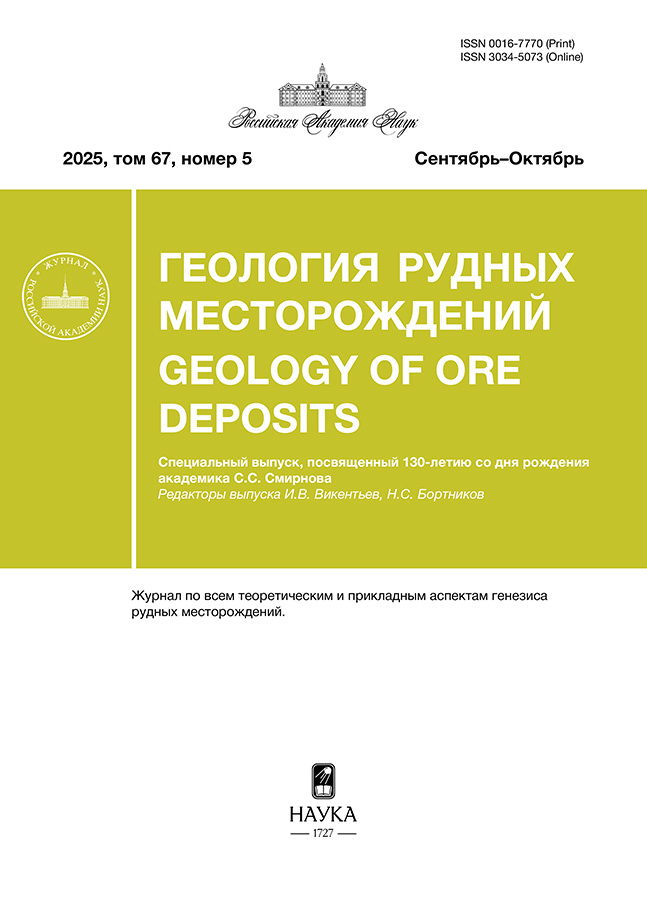Детально изучена блеклая руда эпитермального в терригенных толщах серебро-полиметаллического Мангазейского месторождения (Якутия, Россия), на котором она является главным концентратором серебра. Установлено, что среди минералов группы блеклой руды на Мангазейском месторождении преобладают кеноаргентотетраэдрит-(Zn) и аргентотетраэдрит-(Zn), в меньших количествах встречаются кеноаргентотетраэдрит-(Fe), аргентотетраэдрит-(Fe) и др.; они обнаружены в различных минеральных ассоциациях в тесных срастаниях друг с другом, с сульфидами (галенитом, сфалеритом, арсенопиритом и буланжеритом) и с минералами серебра (диафоритом, овихиитом, пираргиритом, стефанитом, миаргиритом, фрейслебенитом). По данным РСМА химический состав фрейбергитовой серии на Мангазейском месторождении охватывает весь диапазон составов по содержанию Ag (от 3 до 8 а.ф.), образуя твердый раствор с полным почти непрерывным изоморфизмом между одновалентными металлами Ag и Cu и полным непрерывным изоморфизмом между двухвалентными металлами Fe и Zn. В фрейбергитовой серии блеклой руды как в целом на месторождении, так и в зонально-неоднородных агрегатах выявлена обратная корреляция между содержаниями Ag и S. Установлено, что образование неоднородности и осцилляторной зональности в агрегатах блеклой руды Мангазейского месторождения связано с реакциями растворения-переотложения и распадом блеклорудного твердого раствора. На месторождении выделено 4 генерации блеклой руды, различающиеся химическим составом и ассоциирующими минералами. Установлено, что состав блеклой руды связан с составом ассоциирующих с ней минералов: максимальные концентрации серебра присутствуют в блеклой руде, ассоциирующей с пираргиритом и/или миаргиритом; в ассоциациях с халькопиритом блеклая руда с высоким содержанием серебра разлагается с образованием блеклой руды с более низким содержанием серебра; в ассоциациях со сфалеритом встречается исключительно блеклая руда-(Zn). Показано, что от ранних минеральных ассоциаций к поздним (как по минеральному составу руд, так и по химическому составу блеклой руды) происходит обогащение руды серебром при ретроградных реакциях растворения-переотложения. Оцененные по Ag-блеклорудному геотермометру температуры отложения минералов фрейбергитовой серии на месторождении находятся преимущественно в диапазоне 250–170 °С; эти температуры согласуются с температурами отложения, полученными другими методами. Сделан вывод, что блеклорудные ассоциации отложились из более щелочных флюидов, чем ранний кварц; на изменение состава блеклой руды оказывал влияние минералообразующий флюид, а именно содержание металлов и активность хлора и серы в нем; эволюция состава самого минералообразующего флюида связана с вскипанием, смешением и разбавлением флюида и изменениями температуры, сопровождающееся этими событиями. Кеноаргентотетраэдрит-(Zn) и кеноаргентотетраэдрит-(Fe) Мангазейского месторождения являются крайними Ag-, Sb-, Zn- и Fe-членами фрейбергитовой серии с дефицитом серы, содержат максимальные количества серебра и двухвалентных металлов, когда-либо обнаруженные в природе.
 509-526
509-526


 527-559
527-559


 560-590
560-590


 591-613
591-613


 614-640
614-640


 641-677
641-677


 678-711
678-711


 712-740
712-740












